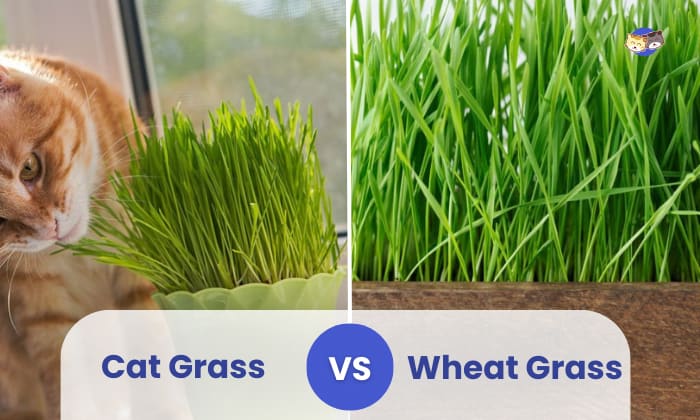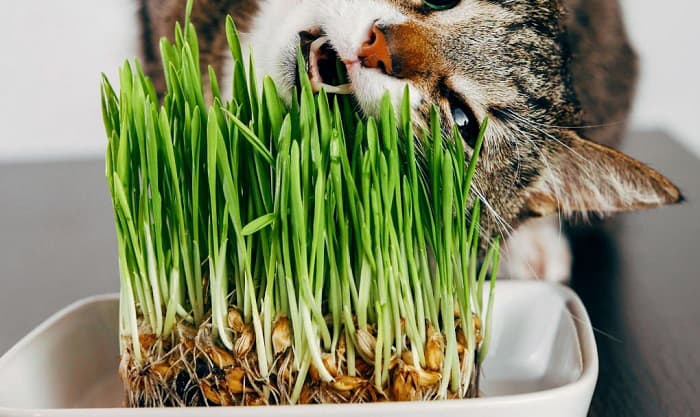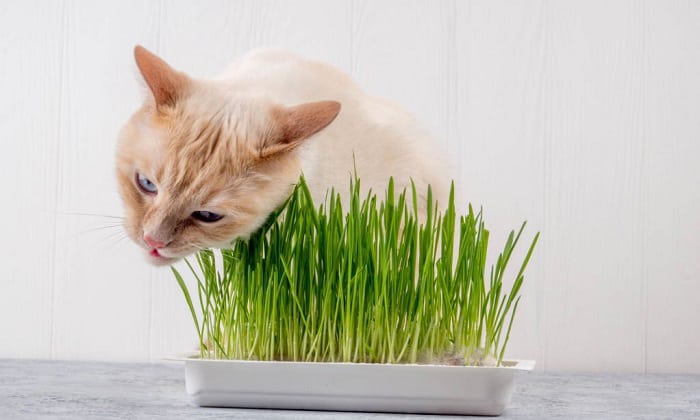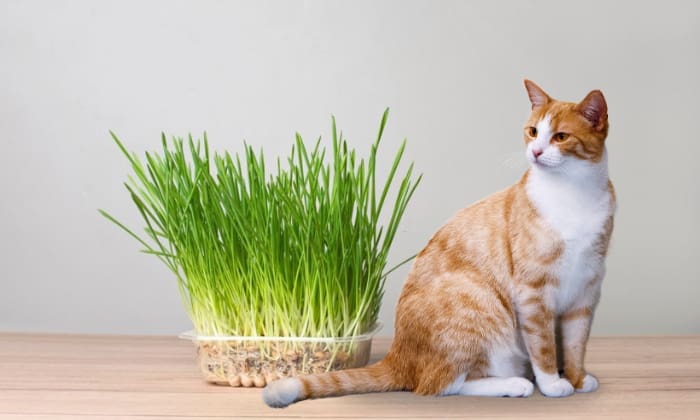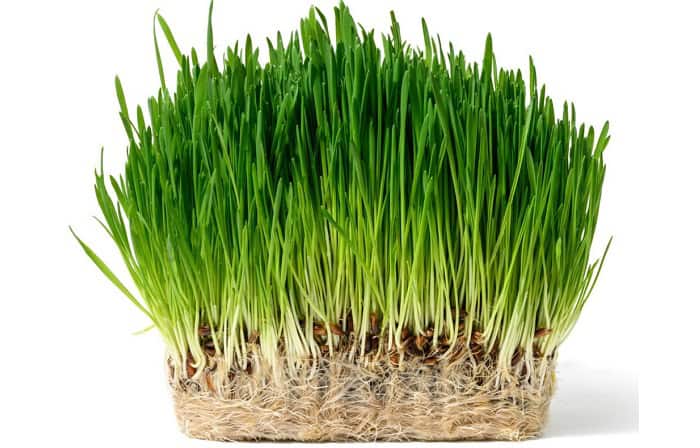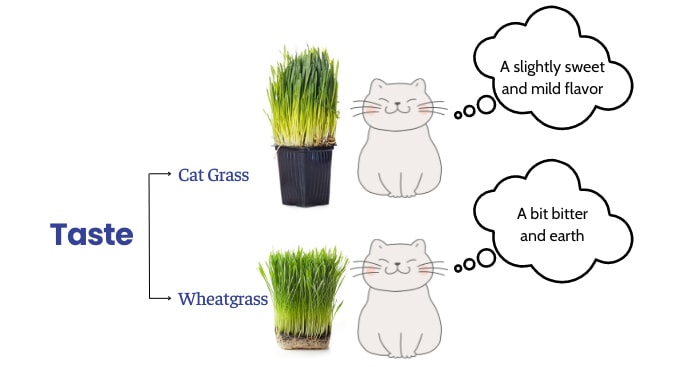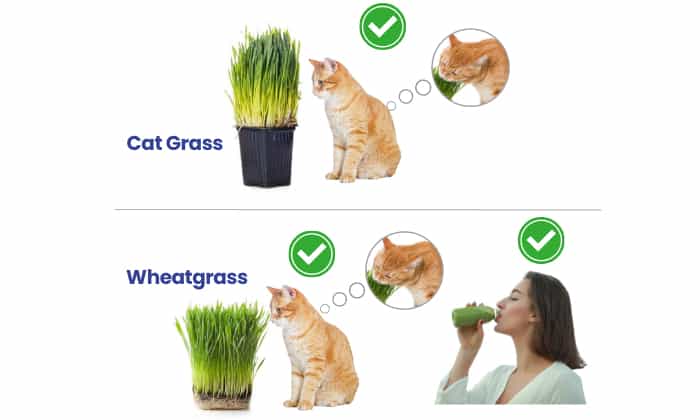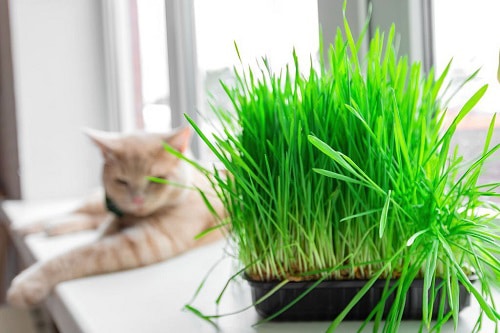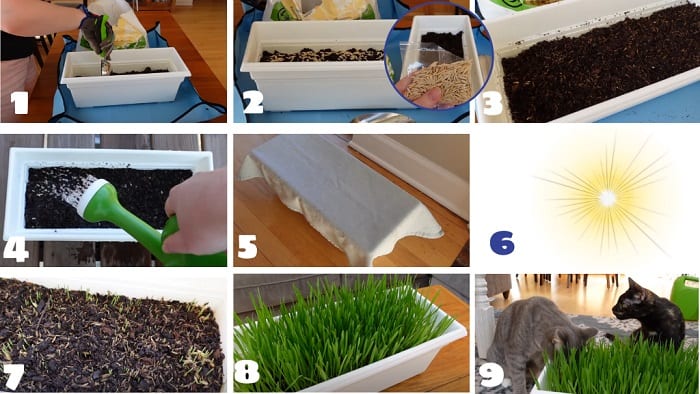Cats are obligate carnivores. Since their digestive systems are specialized to process nothing but animal protein, the sight of cats munching on grass is quite perplexing.
While some cats nibble on grasses when they feel unwell, others truly love sinking their teeth into these greeneries for some sweetness, fun, and additional nutrients.
However, not all grasses are suitable for your feline friends.
In this comprehensive guide, we’ll discuss cat grass vs wheat grass (which might concern those cat owners the most) in terms of their benefits, drawbacks, growing tips, and more to help you decide whether to add them to your cat’s diet.
Table of Contents
What is Cat Grass
Cat grass doesn’t refer to a single type of plant. As long as that plant has grown from one of these barley, rye, oat, or wheatgrass seeds, it’s called cat grass.
Don’t confuse cat grass with catnip since they’re totally different. The latter is also known as catmint or catwort, a common herb of the mint family.
Unlike lawn grass in your yard, cat grass can be cultivated indoors in pots or trays so that it won’t be contaminated with poisonous pesticides and is safe for your pets.
Pros and Cons of Cat grass
1. Pros
Cat grass is safe for feline consumption. Here are some main benefits that make it a good option for those cats who need a specific touch to their diet and additional support to their well-being.
- Help with Digestion
Cat grass can help to reduce the occurrence of hairballs by providing cats with extra fiber to help move hair through their digestive system.
Additionally, grasses also help cats throw up other obstructions in their tummy such as excess bones or skin.
- Provide Nutrients
Cat grass is rich in vitamins and minerals (vitamins A, B, and K, as well as calcium, iron, and magnesium, to name a few). These nutrients are essential for maintaining a cat’s overall health and can help to boost its immune system.
- Provide Mental Stimulation
Many cats enjoy chewing on plants and grass, which can help to relieve boredom and stress. This can be especially beneficial for indoor cats who may not have access to fresh vegetation.
- Prevent Destructive Behavior
Cats have a natural instinct to scratch and chew. Providing cat grass can help to redirect this behavior onto a safe and acceptable outlet, reducing the risk of damage to houseplants or furniture.
2. Cons
Though beneficial to cats, cat grass also has potential drawbacks that might harm your feline. These include:
- Overeating
While cat grass is generally considered safe for cats, some cats may overeat and experience gastrointestinal upset as a result. This is more common in cats with sensitive stomachs.
- Potential Intoxication
While most types of cat grass are safe for cats to eat, there is a risk of intoxicating your pets if the grass is contaminated with pesticides or other chemicals. Thus, it’s important to choose organic grass seeds and avoid using any chemicals when growing the grass.
What is Wheatgrass
Is cat grass the same as wheatgrass? Actually, wheatgrass is one of the frequent varieties of cat grass, which is also considered the best all-rounder thanks to its high concentration of vitamins, minerals, and antioxidants.
The wheat plant that you find in stores is often harvested for its young, tender branch before the grain is formed. That’s why it’s gluten-free, despite its name.
Pros and Cons of Wheatgrass
1. Pros
Generally, wheatgrass has all the benefits that cat grass does. Thus, incorporating wheatgrass into your cat’s diet is also a perfect idea.
Besides, there are some extra benefits of wheatgrass:
- Joint benefits: Rich of vitamin A, B, and minerals, wheatgrass can contribute to joint pain and discomfort in cats.
- Detoxification support: Chlorophyll in wheatgrass is often considered a natural detoxifier, which can improve overall health and potentially slow down the aging process.
- Safe for human consumption: Wheatgrass is commonly consumed by humans in the form of juice or powder as a part of a healthy diet or as a dietary supplement.
2. Cons
Too much wheatgrass for cats is not healthy, and worse, if your cats accidentally munch on some contaminated with herbicides, their health will be in danger.
Additionally, some kittens might get gastric disorders if they nibble on the wheatgrass, leading to some health problems such as diarrhea and loss of appetite.
Wheatgrass Vs Cat Grass: the Differences
1. Taste and Texture
Talking about taste, while cat grass has a slightly sweet and mild flavor, wheatgrass tends to be a bit bitter and earthy (which can be an acquired taste for some pets and people too).
In terms of texture, cat grass like oat or barley is softer and more tender than wheatgrass, which makes it easier for cats to chew and digest. Thus, it’s necessary to keep your eyes on your kitties when they’re consuming tough and more fibrous wheatgrass.
2. Uses
Cat grasses are often grown in small containers indoors. Your pets will directly chomp on their leaves as a healthy snack. While humans can consume cat grass as well, there aren’t many cases where we voluntarily nibble on it.
On the other hand, wheatgrass can be enjoyed by both humans and our pets. Loaded with numerous minerals and vitamins, it’s added to the human diet in the form of juice or smoothies to improve their digestion process, immune system, skin, and more.
So, they are definitely good for cats and humans alike.
3. Cost and Availability
Wondering whether ready-grown grasses are widely available and where to buy them? Actually, you can easily find them at many pet stores or online retailers, with a usual price of below $10.
If you want to grow them on your own, you still have easy access to a wide source of cat grass or wheatgrass seeds. Visit your local pet stores or browse online websites to look for the type you need and place an order. Some garden centers may also carry grass seeds so don’t miss out on these potential places.
It won’t cost you much to prepare this type of dessert for your felines from scratch. Generally, a packet of cat grass seeds can cost anywhere from a few dollars to around $10. If you need a full growing kit, you’ll have to spend at least $15.
Which is Better?
It’s really hard to say whether wheatgrass or cat grass is better for your cat. You should add types of grasses to your feline friend’s diet based on their needs and preferences.
- Both wheatgrass and cat grass offer digestive benefits for cats, providing additional fiber to their diets. However, wheatgrass can supplement several minerals and vitamins – making it a great choice if your cats are lacking these nutrients.
- In general, cat grass is grown specifically for cat consumption, making it 100% safe. Meanwhile, wheatgrass leans more toward human consumption. Though cats can also enjoy this type of grass, extra caution is recommended. Make sure to get organic wheatgrass and introduce it into your cat’s diet gradually.
- Choosing the grass type according to your cat’s preference is also advisable. Cats may prefer the taste and texture of one type to another. You can try offering both types of grass and observe your cat’s response to see which they prefer.
- Additionally, availability and cost can be another source of concern. Make your choice depending on your situation and budget.
Tips to choose the right grass for your cat
- Consider your cat’s preferences
Offer your cats different types of grasses to see which ones they prefer. Once they show a clear preference for one sort of grass over another, you’ll know to stock up on that variety exclusively.
Here are some potential options for your feline friends:
- Wheatgrass is a popular option for cats since it provides essential nutrients and many cats enjoy eating it. It also contains chlorophyll, which can help freshen your cat’s breath.
- Another popular option is oat grass, which is more flavorful than other forms and has a somewhat sweet taste, perfect for even the pickiest pets. It’s also low in calories, making it a good choice for overweight or obese cats.
In spite of its speedy germination and growth, oat grass for cats does not last as long as other types of grass.
- Ryegrass is more adaptable and resilient than its contemporaries. Since cats love to stretch out and munch, this grass is ideal for them.
- Barley grass is another nutritious option for cats. It’s also simple to cultivate and lasts a bit longer than the above types.
- Select organic grasses
Look for organic, pesticide-free grasses to ensure that your cat is having a healthy snack. If you use non-organic seeds, there’s a chance they’ll be laced with harmful chemicals like pesticides.
Plus, avoid grasses that are potentially toxic to cats, such as Bermuda grass, Kentucky bluegrass, or fescue grass.
Growing and Caring Tips
While some cat owners prefer a ready-to-serve dessert for their felines by purchasing pre-grown grasses, others choose to grow them right at home.
Is it hard to grow cat grass and wheatgrass? Not at all!
When you have a full growing kit, growing these grasses is a piece of cake, even if you’re not good at gardening. Since all the grasses need is just light and moisture, caring for them is also a simple process that won’t take you a lot of time and effort.
If you intend to plant wheatgrass or other types like oat or barley on your own, refer to our instructions below for a proper way to grow and care for them.
1. Growing Cat Grass
You can easily grow different types of cat grasses at home, indoors, or outdoors. Just make sure you prepare the followings:
- Cat grass seeds (wheatgrass, barley grass,…)
- Organic, sterile potting soil
- A container made of plastic (or a pot, tray, or pie dish)
- Spray bottle
- Plastic wrap/newspaper
2. Step-by-step Instruction
Before growing wheatgrass for cats, you need to immerse the seeds in water for a full night to make them easier to absorb water and start sprouting.
After that, discard the soaking liquid and flush the seeds with clean water. They’re ready to be used then.
See below for what to do next.
- Fill the container with potting soil, leaving about an inch of space at the top
- Sprinkle the seeds evenly over the soil. Remember that the more seeds you use, the thicker the grass will be
- Fill the remaining one-inch space with soil to make sure that all the seeds are buried
- Water the seeds lightly (but not overwater)
- Cover the container with plastic wrap or a sheet of newspaper to create a humid environment for the seeds to germinate
- Place the container in a warm, bright location (such as a sunny windowsill)
- Once the seeds have sprouted (in about three to seven days), remove the wrap and place the container in a bright location
- Use the spray bottle to water the grass regularly to keep the soil moist
- When the grass reaches 3-5 inches height, it’s ready to be served as a snack for your pet.
3. Tips to Care for Them
Caring for wheatgrass or the other types is easy and requires minimal effort. Here are some tips that you might follow:
- Provide adequate light: Wheatgrass needs bright, indirect light to thrive so make sure to place the container in a bright location. Plus, rotate the container every few days to ensure that all sides of the grass receive adequate light
- Keep the soil always moist: Grass seeds need a moist environment to develop. But don’t let it be soggy or the seeds/roots will be rotten
- Trim regularly: This is for encouraging new growth and preventing them from becoming too tall
- Keep them away from pests (like white worms or slugs) to ensure the best quality.
Frequently Asked Questions
Can you use wheatgrass for cat grass?
As a common type of cat grass, wheatgrass is safe and healthy for your felines to eat. In fact, many people choose to grow wheatgrass since it’s rich in nutrients and vitamins that can be beneficial to a cat’s health.
Just be sure to monitor them when your cats eat wheatgrass, as some cats may have a tendency to overeat or eat too quickly, which can lead to some health problems.
Different types of cat grass
Cat grass is grown from four popular types of seeds, including wheatgrass, oat, rye, and barley. They’re easy to grow and can improve your cats’ well-being.
Among these types, wheatgrass is a common choice for its full nutrients and the long blades which are ideal for cats to chew on. Oat grass is often used as an alternative to wheatgrass because it has a bit sweeter taste and is less likely to cause allergic reactions in cats.
Barley and rye are still beneficial for cats, making a good snack for your felines.
Can cats eat too much grass?
Cats eating a suitable amount of grass is actually quite common and not harmful. However, if they consume it too much, there can be side effects such as vomiting, stomach upset, and even diarrhea.
Additionally, some types of grass may be treated with pesticides or other chemicals, which can be harmful to cats if ingested in large quantities.
Thus, it’s important to monitor your cat’s grass-eating habits and make sure they are not overdoing it. If you notice any signs of vomiting or diarrhea, consult with your veterinarian immediately.
The lifespan of cat grass
Generally, cat grass is a fast-growing plant that can live for two to three weeks. This lifespan varies depending on several factors including the growing conditions and how it’s cared for.
The fact is that you can extend cat grass’s lifespan if you give it proper care such as providing it with adequate sunlight, water, and nutrients. You can also trim the grass regularly to encourage new growth and prevent it from becoming too tall and leggy.
Conclusion
We hope this article helps you understand more about cat grass vs wheat grass, which are both great options for your feline friends. With easy growing and care, these grasses would bring a nutritious and enjoyable touch to a cat’s lifestyle.
The choice between cat grasses may depend on personal preference and the specific needs of the individual cat. If you need extra assistance to make a proper decision, consult with a veterinarian before introducing this new type of supplement to your pet’s diet.

I am Amy Sawy, a Doctor of Veterinary Medicine (DVM) graduate from the University of Kansas. y husband, Dr. Plummer, and I own a veterinary clinic in Phillipsburg, Kansas. In addition to my professional background, I am a devoted pet owner myself, with a household that includes dogs, rodents, and most notably, cats – a total of five felines in my home.
In 2020, I joined an organization as a professional writer, leveraging my experience and collaborating with my team to deliver the most valuable information for your cat’s care.


